May 23, 2025 | 23:06 GMT +7
May 23, 2025 | 23:06 GMT +7
Hotline: 0913.378.918
May 23, 2025 | 23:06 GMT +7
Hotline: 0913.378.918
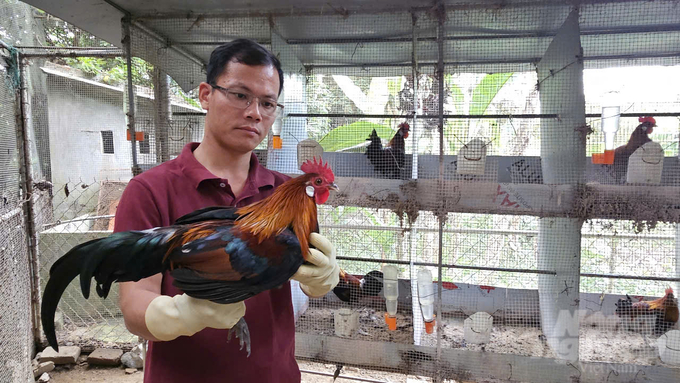
Chinh's red junglefowl farm currently operates at a scale of more than 2,000 heads. Photo: Quoc Toan.
Despite spending most of his life in the city, Le Do Chinh (34 years old, Dong Cuong ward, Thanh Hoa city) still boldly chooses a path unlike any other. Having studied business administration and gained a stable job after graduation, the young man still decided to leave the city to return to his hometown and raise chickens.
Since his student days, Chinh has traveled everywhere to look for agricultural production models suitable for household scale. Among those unforgettable moments, he always lightens up when sharing the story of how he got a taste of red junglefowl in Dak Lak for the first time. The experience was so amazing that the young man felt it was a pity because such a nutritious animal was not widely raised.
The locals also tried raising red junglefowl but to no avail, but Chinh still held on to the idea of domesticating them. However, going from idea to actual implementation was nowhere easy. In 2012, Chinh decided to borrow money to invest in a farm, but after a short time, all the red junglefowl in his farm died.
From 2012 to 2016, Chinh failed repeatedly in domesticating red junglefowls. After each time, he learned many lessons for himself and spent a lot of time researching the red junglefowl’s habits and biological mechanisms. Based on the accumulated knowledge, he built a scientific diet according to each stage of development, and at the same time found a successful formula for raising this particular species.

Red junglefowl possess high nutritional content and economic value. Photo: Quoc Toan.
In the wild, after the chicks hatch, they follow their mother to find food, but when it comes to domesticating red junglefowl, their survival instincts must be changed. In the caged farming environment, failing to secure suitable feed can force both the hen and the chicks to stop eating, leading to stunted growth and death. To change their wild nature, Chinh let the Tre chickens incubate red junglefowl eggs and let the Tre hens raise the chicks. Whatever the Tre hen eats, the chicks will follow.
Red jungle fowls are hard to raise, but easy to consume in the market. “I often sell red jungle fowls through social networks such as Facebook and Zalo. Every time I sell, I post a video describing the product with details such as age and weight so that customers can assess and place orders. Selling on social networks is very convenient, helping to save time and marketing costs,” said Chinh.
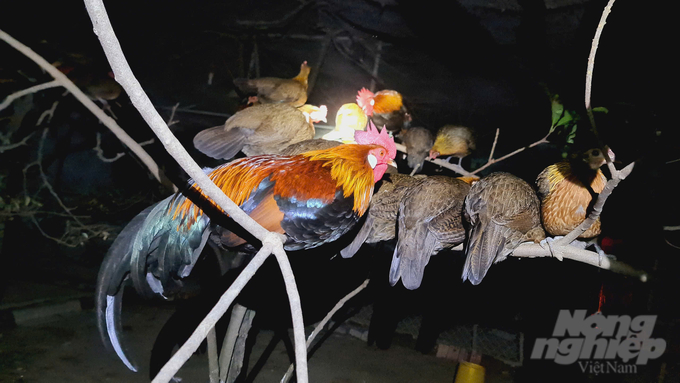
Red junglefowl usually live in flocks and sleep on tree branches. Photo: Quoc Toan.
From Chinh’s experience, in order to have a successful red junglefowl farming model, farmers must have a firm grasp of each stage of the fowl’s growth and development to prevent and treat diseases appropriately. Unlike domestic chickens, red junglefowl have high immunity so they are less susceptible to disease, but farmers should not be negligent in this matter.
Red junglefowl have a shy but very wild nature, so they are difficult to domesticate and very susceptible to stress. This type of species needs a quiet and clean breeding area. During the rainy season, Red junglefowls are susceptible to respiratory diseases, so Chinh often focuses on disease prevention by regularly cleaning the farm, vaccinating and isolating sick fowls to avoid spreading the disease in the flock.
“Regarding disease prevention using vaccines, it should be noted that wild chickens from 1 to 42 days old must be supplemented with 3 types of medicine to avoid diarrhea, typhoid, and coccidiosis. For older junglefowl, regular nutritional supplements must be provided to improve their resistance. Chicks must be kept in high cages to avoid snakes and rats. In winter, the farmer must equip heating lamps to keep the red junglefowl warm,” Chinh said.

Le Do Chinh's red junglefowl farm brings in hundreds of millions of VND in revenue every year. Photo: Quoc Toan.
Red junglefowl often peck at each other when kept together in a cramped space due to a lack of nutrients and minerals. This will cause them to be injured, resulting in an ugly appearance and poor resistance due to the wounds. Farmers therefore need to continuously supplement nutritional mixtures such as aminovita, mineral premix, and Zinmix - A15.
Le Do Chinh's red junglefowl farm of more than 2,000 heads is considered a highly effective model in Thanh Hoa province. Chinh sells 250 - 300 red junglefowl per month. After deducting expenses, each year, the farm owner earns a profit of VND 500 - 600 million.
Each adult red junglefowl normally weighs over 1 kg, but in return, the meat is deliciously firm, so it is quite popular among customers. Although Chinh has continuously expanded the farming area and the scale of the flock in recent times, the commercial red junglefowl supply is still not enough for the market.
Translated by Samuel Pham
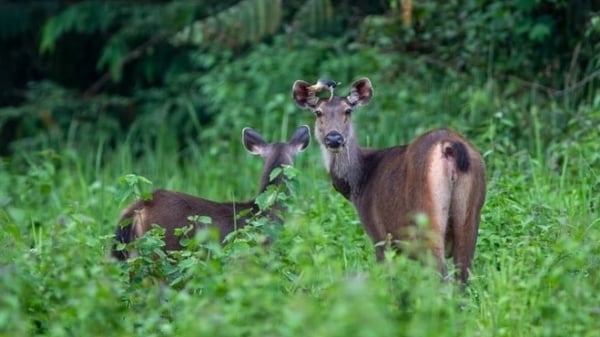
(VAN) WWF, GIZ, IUCN, UNDP call for biodiversity conservation and sustainable development must be regarded as a unity in strategies for a green future.
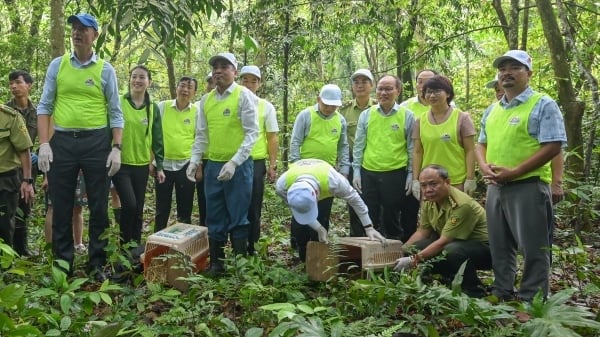
(VAN) On celebration of International Day for Biological Diversity, Deputy Minister Nguyen Quoc Tri called for practical actions to address nature and biodiversity conservation.

(VAN) Dr. Hoang Thi Thanh Nhan – Deputy Director of the Nature and Biodiversity Conservation Agency – highlighted this on the International Day for Biological Diversity, May 22, 2025.
![Ho Chi Minh city adapts to climate change: [2] Accelerating action](https://t.ex-cdn.com/nongnghiepmoitruong.vn/608w/files/chiqk/2025/05/22/4024-4220-bien-doi-khi-hau-1-100626_766.jpg)
(VAN) Clearly recognizing the challenges posed by climate change, Ho Chi Minh city has swiftly shaped its policies and implemented practical solutions to adapt.
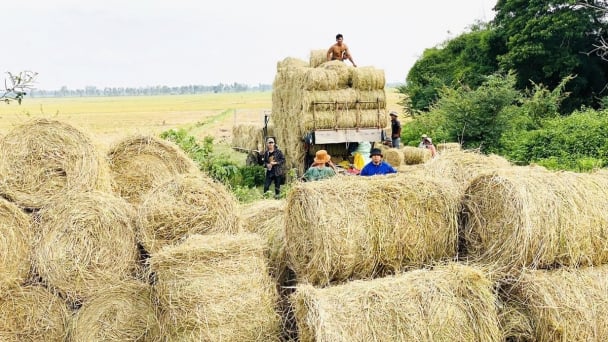
(VAN) Rice straw is no longer just a discarded byproduct, but it is becoming a green resource that helps farmers in the Mekong Delta reduce emissions and promote circular, sustainable agriculture.
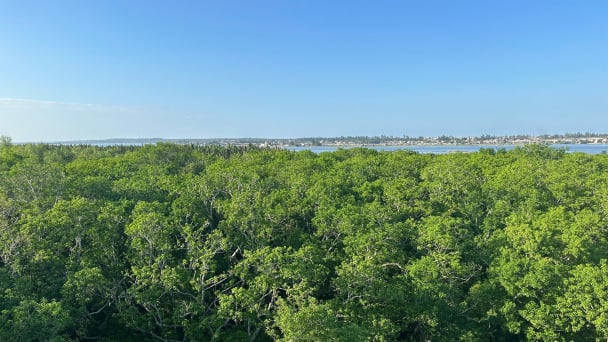
(VAN) Other Effective Area-based Conservation Measures (OECMs) are solutions that contribute effectively to achieving the goals of the Kunming–Montreal Global Biodiversity Framework.

(VAN) A study assessing the carbon footprint of whiteleg shrimp farming in China shows the potential for carbon emission reduction through the use of renewable energy.